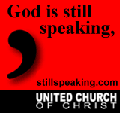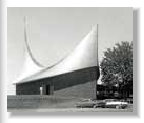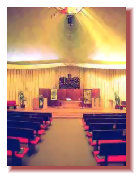

1220 NE
68th St. Vancouver, WA 98665 | | 360-693-1476
Home
Contact
Us
Service
Times
Map
to the Church
Weekly Calendar
Meet
the Staff
Christian
Education
Social
Justice
Photo
Gallery
About
the Ark
Our
Mission Statement
Our
Open and Affirming Covenant
UCC
Statement of Commitment
UCC.org
 Built
in 1959-60 when The Rev. Ted Hastings was pastor, and designed by
architect Warren Weber, the church building was originally thought
to resemble a dove. But most people in the area think of it as
"The Ark on the Hill." Nationally acclaimed for its
unique architecture, the interior features a 120-foot-long
cathedral glass skylight running along the ridge of the roof. The
original Building Committee based the architectural design on
three primary principles:
Built
in 1959-60 when The Rev. Ted Hastings was pastor, and designed by
architect Warren Weber, the church building was originally thought
to resemble a dove. But most people in the area think of it as
"The Ark on the Hill." Nationally acclaimed for its
unique architecture, the interior features a 120-foot-long
cathedral glass skylight running along the ridge of the roof. The
original Building Committee based the architectural design on
three primary principles:
Congregationalists believe that a church at worship is a gathered community seeking guidance of the Holy Spirit in the presence of other people. A seating arrangement which gives maximum feeling of the presence of other worshipers is essential.
The space in which worship takes place should contribute to the feeling of the presence of God. Some form of cathedral space is desirable.
 A
choir should be part of the worshiping congregation, as well as
leaders of worship. Placing it
in a transept makes this dual role possible.
A
choir should be part of the worshiping congregation, as well as
leaders of worship. Placing it
in a transept makes this dual role possible.
The architecht's response to the requests of the Building Committee that those factors be incorporated in our place of worship was as follows:
Seating for the gathered community is usually accomplished in a square building.
The "cathedral feeling" is ordinarily made possible by building in a long, high, narrow rectangular shape.
The use of a transept complicates both.
The architect's solution, therefore, was the oval shape, with an intersecting half-oval transept which incorporated all three of our basic worship needs.
When the Education/Administration wing was adapted to the sweep of the trees and the contour of the land and the roof was upswept to give the cathedral feeling, it appeared to the Building Committee that the church resembled somewhat the shape of a dove. Congregationalists hold as a first theological principle "dependence upon the guidance of the Holy Spirit." A traditional symbol for the Holy Spirit is the dove. It was hoped that the exterior of the church seen from below would speak to people of the descending of the love of God into the lives of people.
To many, however, the building resembles a ship, and if that is what is says to them, it is most appropriate.
To still many others, the upsweeping line of the church, holding the cross high, points outward into the universe to the source of all being. In a day in which people think of God as being not so much "straight up" as "out there" in an ever-expanding universe, this more abstract symbolism seemed appropriate.
 The
cancel is designed to provide both an emotional and intellectual
awareness of the presence of God. To this end, the architect has
created a three-dimensional symbol of the Trinity. The huge, open,
lighted space at the front of the church represents the
transcendent nature of God - that aspect of God's nature which is
outside the world God has created, "unconditioned by any act
of humankind or event in time or space." The reredox screen
of wires and blocks of wood in abstract pattern stands for the
immanent nature of God. The sparseness of the blocks at the top,
their density at the bottom, their apparent origin in infinity,
and the dark color values of the wood create a sensation of gently
falling. The screen is therefore a representation of the Holy
Spirit. The three-dimensionally suspended cross represents the
co-mingling of the transcendent and the immanent natures of God in
the person of Jesus Christ, "very man and very God." The
whole worship area taken together, therefore, reminds us
emotionally and intellectually that we know God in three ways as
Creator, Son and Holy Spirit.
The
cancel is designed to provide both an emotional and intellectual
awareness of the presence of God. To this end, the architect has
created a three-dimensional symbol of the Trinity. The huge, open,
lighted space at the front of the church represents the
transcendent nature of God - that aspect of God's nature which is
outside the world God has created, "unconditioned by any act
of humankind or event in time or space." The reredox screen
of wires and blocks of wood in abstract pattern stands for the
immanent nature of God. The sparseness of the blocks at the top,
their density at the bottom, their apparent origin in infinity,
and the dark color values of the wood create a sensation of gently
falling. The screen is therefore a representation of the Holy
Spirit. The three-dimensionally suspended cross represents the
co-mingling of the transcendent and the immanent natures of God in
the person of Jesus Christ, "very man and very God." The
whole worship area taken together, therefore, reminds us
emotionally and intellectually that we know God in three ways as
Creator, Son and Holy Spirit.
But the greatest symbolism of all is in the whole building taken together in what it says to the community about us. It is our hope that it will say these things to all who behold it:
That this congregation of Christians seeking to be in the presence of God in a gathered community has a mission "to the whole person, to the whole community, and to the whole world."
That in this effort they seek to conserve traditional values of Christian experience in forms appropriate to the times in which they live and work; and
That they are, in the words of Martin Buber: "An Incomprehensibly Daring Fellowship of People," seeking to accomplish their mission with imagination, courage and forthrightness.